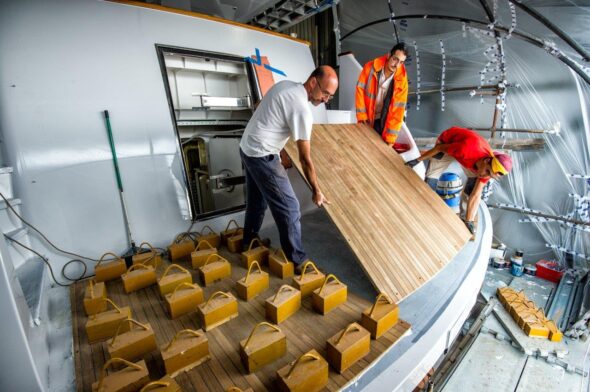The benefits of teak in refitting: a beautiful, healthy and high quality covering for life on board
Using teak during refits is one of the main added values you can give to your vessel. Fulvio Montaldo from Cantieri Navali di Sestri explains why

Using teak during refits is one of the main added values you can give to your vessel. Fulvio Montaldo from Cantieri Navali di Sestri explains why
The benefits of using teak when refitting your boat is one of the reasons this material is one of the most recommended whenever one wishes to refit or modernise their vessel. Whether it is a wooden boat or one in fibreglass, a layer of this wood on deck will bring benefits and added value that go well beyond aesthetics. It guarantees durability, waterproofing and heat insulation.
Teak is a hard wood, obtained from tropical trees, usually found in the tropical and subtropical forests of Southern and South-eastern Asia. The trees usually have a very large trunk that is straight and cylindrical, capable of reaching up to 40 metres in height and a diameter of a metre and a half. In the largest specimens, the base of the trunk can even reach over 10 metres in diameter.
It makes white, scented flowers, but the wood is what has the most commercial value. Teak wood has a colour varying from pale yellow to red and bronze. Its resistance is due to a natural oily resin that protects it from termites.
USING TEAK IN BOATING
Teak supports temperature changes very well, along with humidity, salt spray and weathering, conditions that cause issues with other types of wood. These characteristics make it one of the most hard wearing woods in the world, alongside ebony, lignum vitae and box wood.
We spoke about the use of teak in boating with Fulvio Montaldo, a refit expert and owner of Cantieri Navali di Sestri, where he refits boats of all sizes. Thanks to its characteristics of beauty, durability, resistance, pliancy and immutability, teak is a wood that is excellent for a wide range of applications, including use on board vessels.
“Usually – explains Fulvio Montaldo to Liguria Nautica – teak is laid in 65 millimetre slats for larger vessels, while the width goes down to 40/45 millimetres for smaller vessels, with a thickness varying from 8 to 12 millimetres. Once, vessels used to be built with different thicknesses, but now there are problems with sourcing and the environment.”
The main area teak is sourced from are the natural forests of the Indian peninsula, in particular in Myanmar and Thailand. “Everyone sources from here – notes Montaldo – but it is a tree that grows very slowly. Currently, however, it is the best solution for boat decking. Indeed, still today, having teak decks is an added value for the vessel.”
THE BENEFITS OF TEAK: MORE THAN JUST BEAUTIFUL
Certainly teak decking is beautiful to look at. But there is more than just aesthetics: the benefits of teak during refitting are much more.
“Teak – says the owner of Cantieri Navali di Sestri – makes it so you don’t burn your feet in the summer when walking barefoot on deck and it isolates the rooms from heat. Our ancestors used to use this material to cover the deck because it made sense, certainly not for vanity or fun. This is a slab of wood, with a certain thickness, with certain characteristics that last over time, used to waterproof and insulate.”
In the case in which it is a plastic deck that needs refitting, “it is enough – explains Montaldo – to paint the deck, putting a plastic anti-slip coating, or to paint it, smooth it then cover it with a non-slip layer. But alternatives that please the eye as much as teak don’t exist. If we had to find alternatives to reduce costs, we could use plywood, section it, and paint it with an anti-slip coating, guaranteeing some heat insulation, waterproofing and non-slip properties.”
In some vessels there are already teak slats 3 millimetres thick, with rubber grout. But be careful, “for materials of this type – notes Montaldo – there are problems with durability. It is better to find more economical solutions, but that correspond with the base criteria for which the idea of decking was conceived: durability, waterproofing and insulation”.
There are obviously some exceptions. The needs of a displacement boat are not the same as those of a competitive sail boat, which has, as one of its main needs, keeping the weight down. “The choice – concludes the owner of Cantieri Navali di Sestri – starts with the need of the boat and its owner. We start from here to choose the best solution, respecting weight and aesthetic requirements.”
Topics: Cantieri di sestri, Refitting, teak





